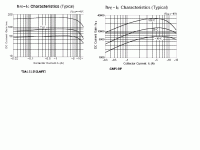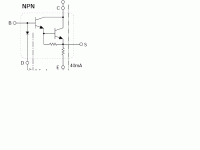Those Sanken SAP devices are found in a surprising number of commercial receivers. After all, they are darlington pairs with built-in temperature compensation, which saves mounting up to three extra devices to the heat sink.
Interestingly, the Sanken data sheets give to f_t information on the SAP devices and they do not say whether the multi-emitter (LAPT) technology is used.
Looking at h_FE vs. I_C for an LAPT and an SAP device, I would assume not:
Interestingly, the Sanken data sheets give to f_t information on the SAP devices and they do not say whether the multi-emitter (LAPT) technology is used.
Looking at h_FE vs. I_C for an LAPT and an SAP device, I would assume not:
Attachments
The other problem with those devices is that the emitter resistor of the driver is hard wired to the integrated emitter resistor of the output transistor.
This means that there is no way for the active transistor to draw charge out of the base of the inactive transistor.
Reading the app note, for currents well in excess of the specified I_C at low V_CE, the integrated emitter resistor should fail before the transistor. From the equivalent circuit, it would seem that discharging a medium sized electrolytic through the E and S terminals would do the job without having to test the limits of the transistor chip. Let's hope it is really the resistor that blows and not the bond wire. If so, a new emitter resistor could be connected to the S terminal, and the 100 R resistor of the driver would be accessible through the E terminal.
This means that there is no way for the active transistor to draw charge out of the base of the inactive transistor.
Reading the app note, for currents well in excess of the specified I_C at low V_CE, the integrated emitter resistor should fail before the transistor. From the equivalent circuit, it would seem that discharging a medium sized electrolytic through the E and S terminals would do the job without having to test the limits of the transistor chip. Let's hope it is really the resistor that blows and not the bond wire. If so, a new emitter resistor could be connected to the S terminal, and the 100 R resistor of the driver would be accessible through the E terminal.
Attachments
Darlingtons have two problems:
1. They offer no access to the emitter of the driver - I explained above how this might be overcome in the SAP devices.
2. There are no extended beta darlintons around (if there are, please point me to them). I had some hope the SAPs might be, but from the curves I doubt that.
1. They offer no access to the emitter of the driver - I explained above how this might be overcome in the SAP devices.
2. There are no extended beta darlintons around (if there are, please point me to them). I had some hope the SAPs might be, but from the curves I doubt that.
I think that the SAP's are merely designed to be compact robust devices for 5.1 amps and suchlike, where space is important. Obviously, there are compromises.
Having said that, I have heard an Arcam DiVA A80 based around these devices, and i have to say the sound was excellent. The amp, if i remember rightly, was based on an opamp frontend using current feedback, driving the darlingtons through pre-drivers, effectively forming a triple.
Having said that, I have heard an Arcam DiVA A80 based around these devices, and i have to say the sound was excellent. The amp, if i remember rightly, was based on an opamp frontend using current feedback, driving the darlingtons through pre-drivers, effectively forming a triple.
- Status
- This old topic is closed. If you want to reopen this topic, contact a moderator using the "Report Post" button.

